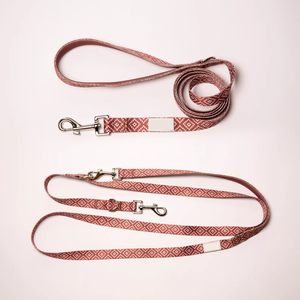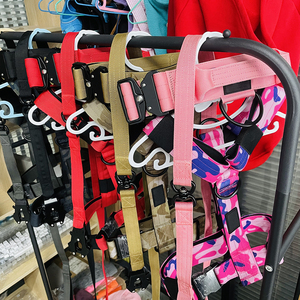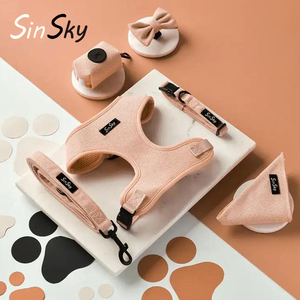(15403 products available)


































































































































































































The type of no pull dog harness described below helps control and train dogs effectively while reducing pulling behavior during walks.
Front clip harnesses
This design has a leash attachment on the dog's chest. It allows for better control over the dog and helps to steer them around when they try to pull. The front clip stops them from moving forward as much, which discourages pulling. It also makes it easy to control big or strong dogs and helps train them not to pull.
Front clip harness with an additional back clip
Like the previous one, this type has a front clip for the leash on the chest and another clip on the back for attaching to the harness. This design is versatile because users can use it for both training and everyday walks. The front connection helps prevent pulling, and the back is suitable for casual walks or attaching to training leashes.
Back clip harnesses
This popular design has a leash attachment at the back, near the dog's tail. It is best for dogs who do not pull much on their leashes. This type distributes pressure evenly across the dog's body and is also good for small breeds or those with neck problems. It is easy to put on and take off and gives the owner freedom when walking.
Adjustable harnesses
These models have different areas where they can be changed or adjusted to fit the dog. This makes it easier to get a good fit, especially if the dog is still growing or has an unusual shape. It stops the harness from being too tight or loose, which could cause discomfort or not work well. With adjustable parts, users can be sure their harness fits just right every time without any trouble.
Material used in making them
Durable materials like nylon, polyester, or neoprene are commonly used to make no-pull dog harnesses. These fabrics resist wear and tear from outdoor activities and are waterproof, so they do not absorb much water during rainy weather. They are also lightweight, which reduces the total weight carried by both owner and pet while walking. Additionally, soft yet tough materials ensure that no areas rub against the dog's skin, preventing chafing or discomfort.
Chest Strap:
A chest strap is a critical component of a no-pull dog harness. It is designed to fit comfortably around the dog's chest, just behind the front legs. This strap is usually broader and padded to distribute pressure evenly across the dog's chest, preventing injuries and ensuring comfort during walks. The chest strap is integral to the harness. It helps control the dog and teaches them not to pull. It does this by redirecting the dog's movement. When a dog pulls on the leash, the harness turns them around or makes them face the owner. This is gentle and does not hurt their neck like some collars can. A good chest strap is strong but soft. It helps the dog learn to walk better without pulling and keeps walks safe and pleasant for everyone.
Fabric:
A fabric no-pull dog harness is a good choice for comfort, strength, and flexibility. Fabrics like nylon are popular because they are light but also very tough and last a long time. Fabric harnesses often have soft padding inside, especially in areas that touch the dog's body a lot, like the chest and straps. This makes sure the harness is comfortable and does not cause rubbing or chafing, even if the dog wears it for a long time or during exciting walks. Fabric harnesses dry faster than others. This is important if the dog gets wet from the weather, water, or playing. It also matters if the harness needs to be cleaned because fabric harnesses can get dirty too. Fabric harnesses can be put on and adjusted easily. This is important for busy dog owners who need to get their dog ready fast. It also means the harness can fit different dog shapes and sizes well. Overall, fabric no-pull dog harnesses are useful for many dogs because they balance comfort, durability, and ease of use.
Adjustable Straps:
Adjustable straps on a no-pull dog harness are important to ensure a good fit for different dogs. These straps can be changed to fit the dog well. This is important so the harness does not slip off or hurt the dog. It also ensures the harness works well to stop pulling. With adjustable straps, the harness can be made tighter or looser as needed. This is good for dogs that grow, lose weight, or change size. It also helps if the harness is shared between dogs or used with different breeds. Straps that adjust allow the harness to fit comfortably without being too tight or loose anywhere. This keeps the dog safe and makes sure it works to prevent pulling. It also means the harness can be used longer as the dog changes size or if used with different dogs. Overall, adjustable straps on a no-pull harness are useful for making it fit well and work well for stopping pulling behavior.
Dog Training
A no pull harness for large dogs is an important tool during training sessions. It gives dog owners better control over their pets, which is useful when teaching commands or correcting behavior. The harness makes it easier to guide the dog and helps them learn faster.
Daily Walks
No pull dog harnesses are great for daily walks, especially with energetic dogs that tend to pull on the leash. These harnesses reduce strain on the owner's arms and hands, making walks more enjoyable. They prevent pulling, so both the dog and owner can walk calmly together.
Hiking and Adventure
For outdoor activities like hiking, a no pull harness is very useful. Active dogs may be excited to explore nature, but this harness gives the owner control over steep trails or busy areas. Some models even have extra features like attachment points for backpacks or water bottles.
Veterinary Visits
No pull harnesses come in handy for vet visits or any other situations requiring close control of the dog. It calms anxious pets down during examinations and prevents them from pulling away. This makes it easier for veterinarians to work with the dogs they care for.
Dog Socialization
Dog owners who want to socialize their pets can use no pull harnesses in training classes or dog parks. These harnesses give them better control over their dogs, thus ensuring safety when interacting with other animals. They are especially helpful for young dogs who are still learning how to behave around others.
To choose a no pull dog harness, these factors should be considered:
Size and Breed
Small dogs and large dogs need different no pull dog harnesses. Also, the dog harness should be able to accommodate the dog as it grows. Some harnesses are made for certain dog breeds. Consider the dog's breed and get a harness that fits well.
Material and Durability
Dog harnesses have different materials, like nylon and polyester. These materials are strong and easy to clean. Consider the dog's activity level. Get a harness with durable materials if the dog is very active. Less durable materials are okay for less active dogs.
Comfort and Fit
The harness should fit the dog well. It should be comfortable and not too tight or loose. Some harnesses have padding for comfort. Try the harness on the dog. There should be no more than 2 inches of space between the harness and the dog's skin. The dog should be comfortable and move freely in the harness.
Ease of Use
No pull dog harnesses are easy to put on and take off. Some have adjustable straps and quick-release buckles, which make them easy to use. Look for a harness that is simple and doesn't take much time to use.
Train Features
No pull harness features aid in dog training. Some features reduce pulling. Others have front-clip designs that let the owner control the dog's movement better. Choose a harness with features that help train and manage the dog.
Leash Attachment
Check if the harness has a place to attach the leash. Some harnesses have front and back attachment points for more control. Pick a harness that allows for easy and secure leash attachment.
Adjustability
Adjustable harnesses can fit dogs of different sizes. They are good for dogs that are still growing. Some harnesses have multiple adjustment points, making it easy to get a snug fit. Get an adjustable harness if the dog's weight changes often.
Recommended by Experts
Check reviews and expert recommendations to know popular dog harnesses. Get a harness that many dog owners trust.
Q1. Why is a no-pull harness used instead of a collar?
A1. No-pull dog harnesses distribute the pulling force across the dog's body, minimizing the risk of injury to the dog's neck and giving the owner more control over the dog.
Q2. How does a no-pull harness stop a dog from pulling?
A2. No-pull harnesses have special features like front leash attachments and shoulder straps that discourage pulling by turning the dog around or giving a gentle nudge when they pull.
Q3. How should a dog harness fit?
A3. It should be snug but not too tight, allowing the dog to move freely with no more than two fingers' worth of space at the dog's body.
Q4. What size dog harness should I get?
A4. Measure the dog's girth, which is the widest part of their chest, just behind the front legs. Then, consult the size chart provided by the harness manufacturer, as sizes can vary.
Q5. What are the benefits of using a no-pull dog harness?
A5. They improve control during walks, reduce strain on the dog's body, especially the neck, and make walks more enjoyable for both the dog and the owner by discouraging pulling behavior.
The web search volume for the keyword "no pull dog harness" shows a stable pattern with an average monthly web search volume of 18,100. Over the past year, the web search volume has not experienced any significant change, maintaining a zero percent year-over-year growth rate. However, there has been a notable three-month decline of 18%.
Analyzing the monthly search data reveals a consistent web search volume throughout most months, with peaks in March, April, May, and August, where web searches increased to 22,200. The valleys, or periods of lower web search volume, are observed in the months following these peaks, reverting back to the average of 18,100.
This trend suggests a pattern of fluctuation, likely influenced by seasonal behaviors or market events that temporarily increase interest in no pull dog harnesses. The peaks could be associated with specific times of the year when pet owners are more inclined to purchase new accessories, possibly due to changes in pet walking routines or the introduction of new dog breeds into households during certain seasons. This analysis points to a cyclic interest in this product category, which could be further explored for strategic marketing and stock planning.